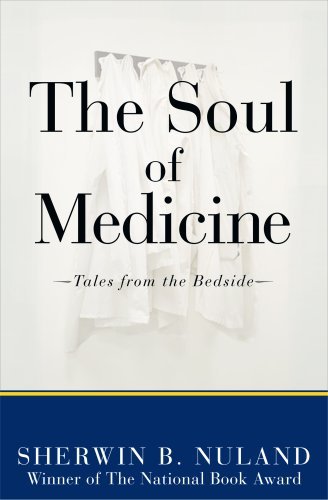For generations, we have placed physicians on a pedestal. Sure, we complain about them and the cost of health care but when it comes down to it, we pay attention because we respect and rely on their knowledge and training. Dr. Sherwin B. Nuland, a surgeon, has spent much of his equally successful writing career trying to not only demystify medicine but showing that the people who practice it are as human as the rest of us. His latest work, The Soul of Medicine, is another step along that road.
 Nuland gained acclaim with How We Die: Reflections on Life’s Final Chapter, which won the National Book Award in 1994. Highly informative yet unflinching, it sought to detail just what happens when we die. He gave us a doctor’s view with, among others, The Uncertain Art: Thoughts on a Life in Medicine, a collection of essays. And he showed us just how human doctors are when he was brave enough to pen Lost in America: A Journey with My Father, a memoir in which he detailed a depression so severe that he almost had a lobotomy to try to cure it.
Nuland gained acclaim with How We Die: Reflections on Life’s Final Chapter, which won the National Book Award in 1994. Highly informative yet unflinching, it sought to detail just what happens when we die. He gave us a doctor’s view with, among others, The Uncertain Art: Thoughts on a Life in Medicine, a collection of essays. And he showed us just how human doctors are when he was brave enough to pen Lost in America: A Journey with My Father, a memoir in which he detailed a depression so severe that he almost had a lobotomy to try to cure it.
The Soul of Medicine is not as strong or compelling as How We Die or Lost in America. Because it collects the personal stories of more than a dozen physicians regarding their most memorable patients, it is closer to his essay collection. Nuland tells each story from the first person perspective of each narrator in the unrelated tales. In the prologue, he explains that he does so to help mask details that might breach confidentiality and to also allow him to provide commentary on various stories. Nuland indicates he wants this to be “a sort of Canterbury Tales of medicine,” one by which to examine the dynamic relationships, particularly doctor-patient, that arise in the practice of medicine.
While Nuland seeks to illuminate personal aspects of the practice of medicine and Canterbury becomes the name of the hospital in many of the stories, the book cannot invoke as many perspectives as The Canterbury Tales. Just as the stories span a time frame from World War II through today, they cover a broad range of issues — some seemingly more relevant than others — and characters both heroic and despicable. Several show how the doctor learns from the patient. Others are inspiring or touching, such as the elderly man whose stroke-like episode left him having hallucinations of his deceased wife’s face. When offered a drug that would stop the hallucinations, he declined it. He preferred seeing his wife’s face.
Nuland himself tells of the doctor-patient relationship from the perspective of him being the father of the patient. With that exception, these stories are told from the standpoint of the doctor. Often, they are as much about the doctor as their teacher or patient. And some are not afraid to relate tales where the conduct was not exemplary. Thus, an anesthesiologist recalls a respected and talented surgeon with bipolar disorder who went off his meds while on vacation. Upon entering the operating room for a routine gall bladder operation, the surgeon groped a nurse and sped into the operation, including removing and discarding part of a healthy stomach and slashing the patient’s aorta before being restrained by three orderlies. Then there’s the chest surgeon who admits still having “a perverse pride” in getting a night nursing supervisor fired before she could report his sexual tryst with a student nurse
Yet one public breach of decorum is also one in which the actions are most understandable. A neurosurgeon recalled a two-and-a-half-year-old boy who suffered a fatal brain injury when his mother’s boyfriend threw him against a wall. During their efforts to save the boy, the medical team discovered a body covered in days old bruises and with an extensive tear in the rectum. As the neurosurgeon went to tell the mother the child had died, he spotted the boyfriend, already in police custody.
I could not help turning to the behemoth and positioning myself on a chair so that my face was within inches of his bloodshot and now terrified eyes. I wanted to be sure that he could see the bits of brain clinging to my gown, the front of which was soaked in the fresh still-scarlet blood of the child he had killed. “This is what you did,” was all I was able to say, because I was afraid I would vomit if I tried to speak another word.
To make sure there was no doubt left for law enforcement, the doctor concluded the operative chart with the handwritten entry, “The mother and her boyfriend are the stuff of worst nightmares.”
Fortunately, most of the memorable patients in this collection are not involved in nightmare tales. And while their stories may not always end happily, they do help illuminate the range of experiences in the day-to-day practice of medicine.
To be told by your patient that he has confidence in you, even as your inability to help him becomes increasingly clear, is to feel like the worst hypocrite in the world.
Sherwin Nuland, The Soul of Medicine







